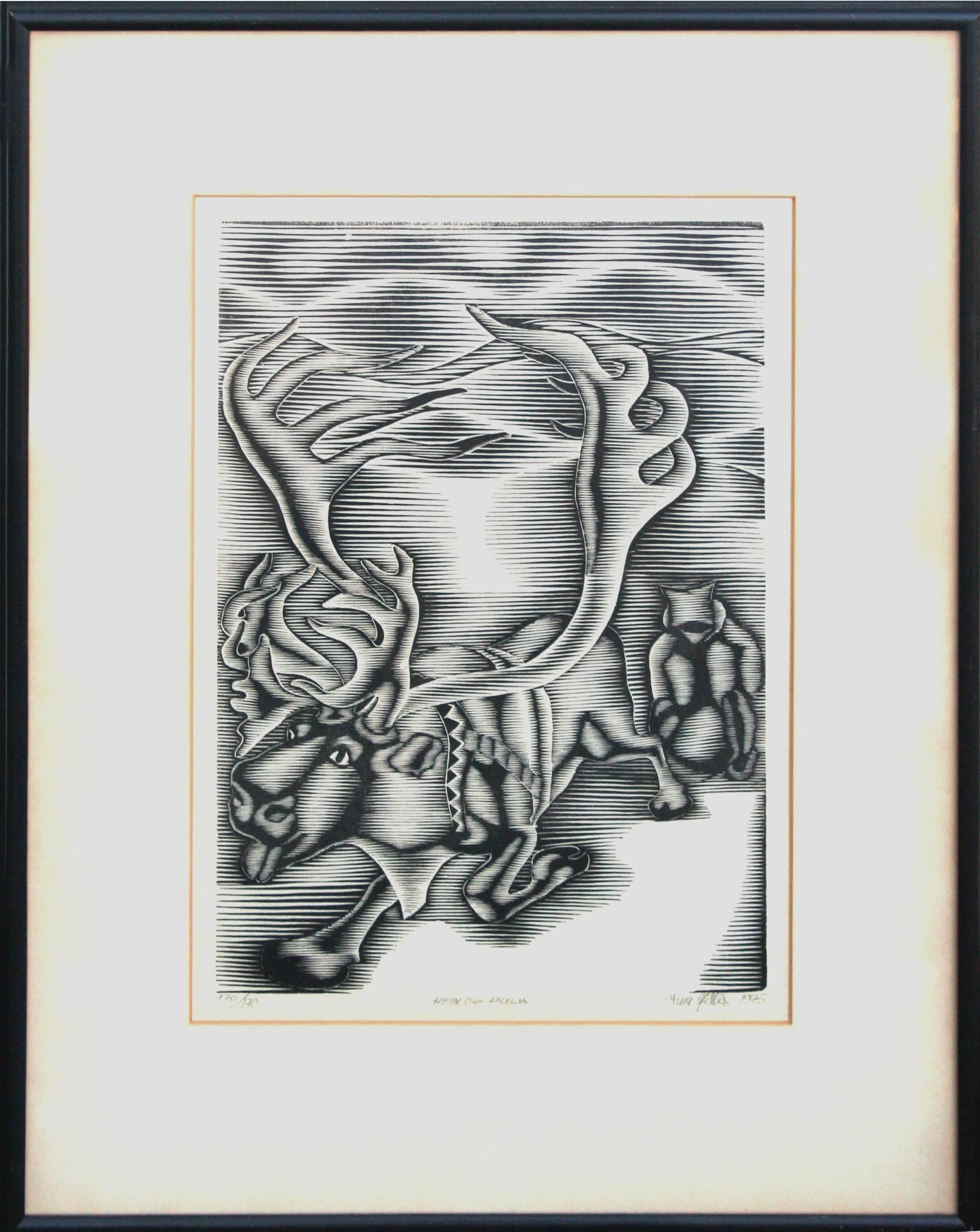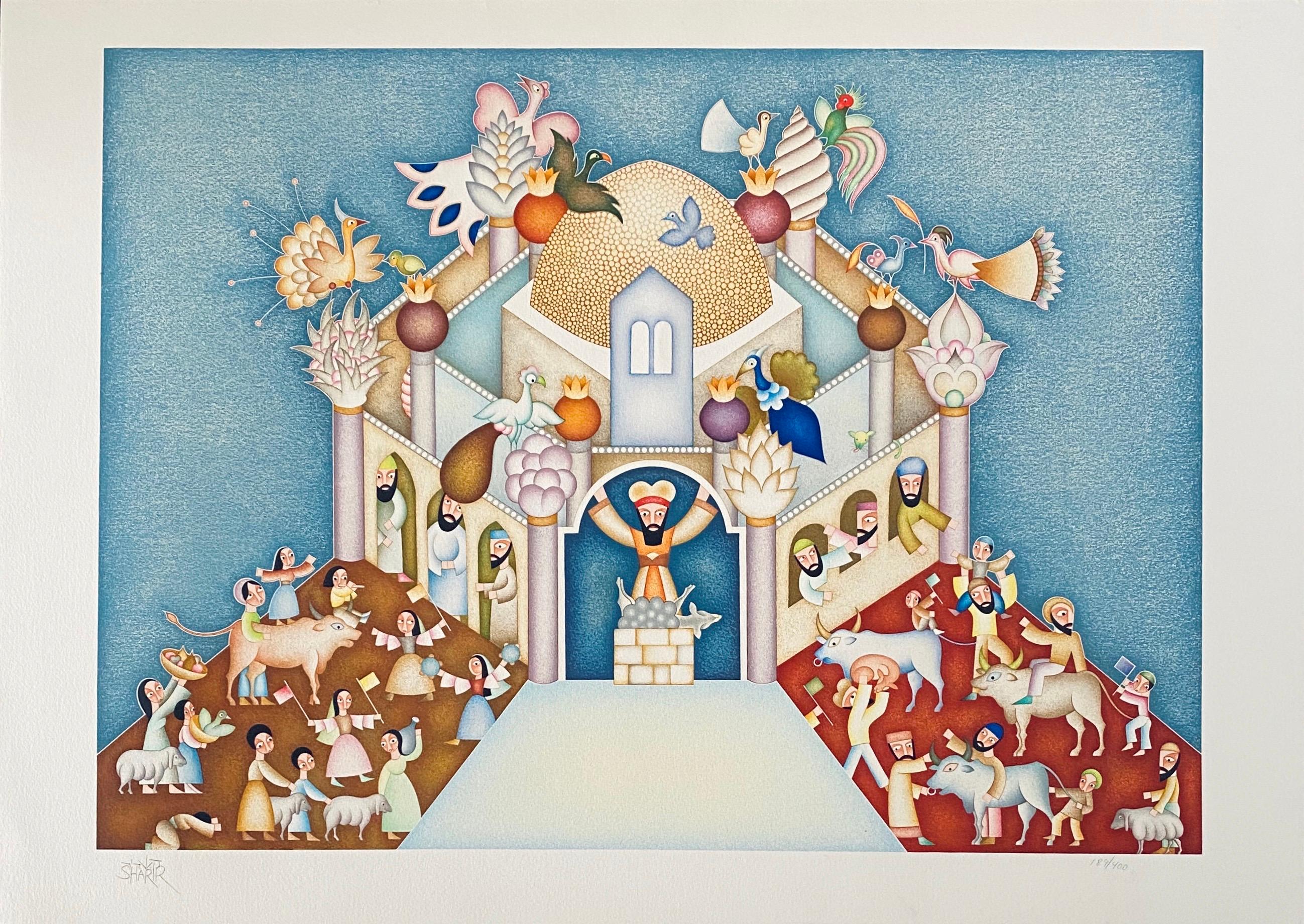Items Similar to Panther - Figurative Abstract Woodcut, 3/10
Want more images or videos?
Request additional images or videos from the seller
1 of 8
Cecelia Sánchez DuartePanther - Figurative Abstract Woodcut, 3/101990
1990
About the Item
Figurative abstract wood cut print titled "Copula Blanca" by Cecelia Sánchez Duarte. Pencil signed with edition number "3/10," title, and signature bottom margin. Image, 31.25"H x 23.13"W.
Cecelia Sánchez Duarte is a visual artist and a cultural activist. Cecelia also teaches Art History at Escuela Profesional de Danza de Mazatlán, is the Fine Arts Coordinator at Centro Municipal de Artes, cofounder of the new Técnico en Artes Plásticas and founder of a painting workshop for children. She has had more than 300 collective exhibits internationally as well as 17 solo shows. Cecelia Sánchez Duarte lives in Mazatlán, Mexico.
- Creator:Cecelia Sánchez Duarte (Mexican)
- Creation Year:1990
- Dimensions:Height: 44.25 in (112.4 cm)Width: 30 in (76.2 cm)Depth: 0.07 in (1.78 mm)
- Medium:
- Movement & Style:
- Period:
- Condition:Very Good. Some minor age wear to edges and small slit at left center edge. A few minor foxing spots at margins. Full sheet of paper folded by artist 2.5 inches from bottom edge; which is 6 inches below edge of image; this is intentional.
- Gallery Location:Soquel, CA
- Reference Number:
About the Seller
5.0
Platinum Seller
These expertly vetted sellers are 1stDibs' most experienced sellers and are rated highest by our customers.
Established in 1986
1stDibs seller since 2014
2,510 sales on 1stDibs
Typical response time: <1 hour
- ShippingRetrieving quote...Ships From: Soquel, CA
- Return PolicyA return for this item may be initiated within 14 days of delivery.
More From This SellerView All
- Rein Og Pulk (Reindeer and Sleighs) - Laplander Sami in his PulkBy Yuri MotLocated in Soquel, CAJoyful image of a woodcut print of a Reindeer pulling a Laplander Sami in his Pulk (small toboggan), a traditional scene in Lapland folklore and history by Yuri Mot. Signed indistinc...Category
1970s Folk Art Figurative Prints
MaterialsWoodcut, Laid Paper
- "The Engraver" Double Layer Woodblock PrintLocated in Soquel, CABold woodcut print by M. Sheppard (20th Century). This piece is filled with Neolithic imagery of people and animals. There are two figures that are engaged in hunting and several pre...Category
1980s Other Art Style Figurative Prints
MaterialsPaper, Ink, Woodcut
- "The hen that lays is the hen that pays" Screenprint on PaperLocated in Soquel, CA"The hen that lays in the hen that pays" Screenprint on Paper Bold screenprint by Toni Carner (American, b. 1957). A large, patterned hen is sitting on th...Category
1970s Minimalist Figurative Prints
MaterialsInk, Screen, Paper
- 1970's Figurative Home Interior Etching, Portrait of a Couple with DogsLocated in Soquel, CA1970's modernist etching of a man and woman at home with their dogs by Stephen Martin (American, 20th Century). The enigmatic couple both wear sungla...Category
1970s Contemporary Figurative Prints
MaterialsPaper, Ink, Etching
- Conversations at the Bar - Figurative Animal EtchingLocated in Soquel, CA1970's modernist anthropomorphic animals at a bar by Stephen Martin (American, 20th Century). Several animals sit at a bar, with a few in the b...Category
1970s Contemporary Figurative Prints
MaterialsPaper, Ink, Etching
- "Nohubo remedio" (There was no remedy) - Etching and Aquatint on PaperBy Francisco GoyaLocated in Soquel, CA"Nohubo remedio" (There was no remedy) - Etching and Aquatint on Paper Bold 3rd or 4th edition, circa 1868-1878, with burnished aquatints, drypoints etching, and engravings by Franc...Category
1790s Old Masters Figurative Prints
MaterialsEngraving, Paper, Etching, Aquatint
You May Also Like
- Feast and singing. 1984. Paper, linocut, 20x34 cmBy Dainis RozkalnsLocated in Riga, LVFeast and singing. 1984. Paper, linocut, 20x34 cm imprint size 10x26 cm total page size 20x34cm Dainis Rozkalns (1928 - 2018) Artist, graphic artist, illustrator of folklore and fi...Category
1980s Folk Art Figurative Prints
MaterialsPaper, Linocut
- Frontline and Homefront diptychBy Harry BunceLocated in Deddington, GBHarry Bunce Love Wars Series, Frontline Limited Edition Hand Pulled Silkscreen Image Size: H 63cm x W 49cm x D 0.1cm Mounted Size: H 73cm x W 59cm x 0.5cm So...Category
21st Century and Contemporary Folk Art Animal Prints
MaterialsPaper, Screen
- Israeli Naive Folk Art Silkscreen Lithograph David Sharir - Bet Hamikdash SceneBy David SharirLocated in Surfside, FLDavid Sharir was born in 1938 in Tel Aviv, Israel and currently resides there. David Sharir, the son of Russian immigrants, was born in Israel. Beginning his study of art in Tel Aviv and continuing in Florence and Rome, where he studied architecture and theater design. The brightly colored costumes and intricate stage designs he created for these productions have profoundly influenced his art. When Sharir moved to Old Jaffa in 1966, his hallmark style was truly developed. Studio, family, and spiritual devotion all serve as inspiration for the imagery in his work. His evolving style combines personal experience, Biblical symbolism, and fantasy. Israel has had a Vibrant Folk Art, Naive art scene for a long time now artists like Yisrael Paldi, Nahum Guttman, Reuven Rubin and even Yefim Ladyzhensky had naive periods. The most well know if the strict naive artists are Shalom of Safed, Irene Awret Gabriel Cohen, Natan Heber, Michael Falk Kopel Gurwin. Sharir depicted biblical subjects with a touch of humour and designed sets and costumes for the theatre and opera. Graphic Art in Israel Today Tel Aviv Museum, Tel Aviv 1973 Israel 1948-1958: Watercolors, Drawings, Graphics The Bezalel National Museum, Jerusalem 1958 Jean David, Yosl Bergner, Menachem Shemi, Zvi Mairovich, Ruth Schloss, Nahum Gutman...Category
20th Century Folk Art Figurative Prints
MaterialsScreen
- Israeli Naive Folk Art Birdhouse Silkscreen Lithograph David Sharir BirdsBy David SharirLocated in Surfside, FLDavid Sharir was born in 1938 in Tel Aviv, Israel and currently resides there. David Sharir, the son of Russian immigrants, was born in Israel. Beginning his study of art in Tel Aviv and continuing in Florence and Rome, where he studied architecture and theater design. The brightly colored costumes and intricate stage designs he created for these productions have profoundly influenced his art. When Sharir moved to Old Jaffa in 1966, his hallmark style was truly developed. Studio, family, and spiritual devotion all serve as inspiration for the imagery in his work. His evolving style combines personal experience, Biblical symbolism, and fantasy. Israel has had a Vibrant Folk Art, Naive art scene for a long time now artists like Yisrael Paldi, Nahum Guttman, Reuven Rubin and even Yefim Ladyzhensky had naive periods. The most well know if the strict naive artists are Shalom of Safed, Irene Awret Gabriel Cohen, Natan Heber, Michael Falk Kopel Gurwin. Sharir depicted biblical subjects with a touch of humour and designed sets and costumes for the theatre and opera. Graphic Art in Israel Today Tel Aviv Museum, Tel Aviv 1973 Israel 1948-1958: Watercolors, Drawings, Graphics The Bezalel National Museum, Jerusalem 1958 Jean David, Yosl Bergner, Menachem Shemi, Zvi Mairovich, Ruth Schloss, Nahum Gutman...Category
20th Century Folk Art Figurative Prints
MaterialsScreen
- Feeding the RavensLocated in San Francisco, CAThis artwork titled "Feeding the Ravens" 1997 is a color offset lithograph on paper by noted American artist Rie Mounier Munoz, 1921-2015. It is hand signed and numbered 29/950 in pencil by the artist. The image size is 9.65 x 8.35 inches, sheet size is 13.85 x 12.25 inches. It is in excellent condition, has never been framed. About the artist: Alaska painter Rie Mounier Munoz was the child of Dutch parents who immigrated to California, where she was born and raised. She is known for her colorful scenes of everyday life in Alaska. Rie (from Marie) Munoz (moo nyos), studied art at Washington and Lee University in Virginia. In 1950, she traveled up the Inside Passage by steamship, fell in love with Juneau, and gave herself until the boat left the next day to find a job and a place to live. Since then Juneau has been home to Munoz. She began painting small vignettes of Alaska soon after arriving in Juneau, and also studied art at the University of Alaska-Juneau. Munoz painted in oils in what she describes as a "painstakingly realistic" style, which she found stiff and "somewhat boring." Her breakthrough came a few years later when an artist friend introduced her to a versatile, water-soluble paint called casein. The immediacy of this inexpensive medium prompted an entirely new style. Rie's paintings became colorful and carefree, mirroring her own optimistic attitude toward life. With her newfound technique she set about recording everyday scenes of Alaskans at work and at play. Of the many jobs she has held journalist, teacher, museum curator, artist, mother, Munoz recalls one of her most memorable was as a teacher on King Island in 1951, where she taught 25 Eskimo children. The island was a 13-hour umiak (a walrus skin boat) voyage from Nome, an experience she remembers vividly. After teaching in the Inupiat Eskimo village on the island with her husband during one school year, she felt a special affinity for Alaska's Native peoples and deliberately set about recording their traditional lifestyles that she knew to be changing very fast. For the next twenty years, Rie practiced her art as a "Sunday painter," in and around prospecting with her husband, raising a son, and working as a freelance commercial artist, illustrator, cartoonist, and curator of exhibits for the Alaska State Museum. During her years in Alaska, Munoz has lived in a variety of small Alaskan communities, including prospecting and mining camps. Her paintings reflect an interest in the day-to-day activities of village life such as fishing, berry picking, children at play, as well as her love of folklore and legends. Munoz says that what has appealed to her most were "images you might not think an artist would want to paint," such as people butchering crab, skinning a seal, or doing their laundry in a hand-cranked washing machine. In 1972, with her hand-cut stencil and serigraph prints selling well in four locations in Alaska, she felt confident enough to leave her job at the Alaska State Museum and devote herself full time to her art. Freed from the constraints of an office job, she began to produce close to a hundred paintings a year, in addition to stone lithograph and serigraph prints. From her earliest days as an artist, Rie had firm beliefs about selling her work. First, she insisted the edition size should be kept modest. When she decided in 1973 to reproduce Eskimo Story Teller as an offset lithography print and found the minimum print run to be 500, she destroyed 200 of the prints. She did the same with King Island, her second reproduction. Reluctantly, to meet market demand, she increased the edition size of the reproductions to 500 and then 750. The editions stayed at that level for almost ten years before climbing to 950 and 1250. Her work has been exhibited many solo watercolor exhibits in Alaska, Oregon and Washington State, including the Charles and Emma Frye Art Museum, Alaska State Museum in Juneau, Anchorage Historical and Fine Arts Museum, Tongass Historical Museum in Ketchikan, and Yukon Regional Library in Whitehorse; Yukon Territory, and included in exhibits at the Smithsonian Institute and Russell Senate Office Building in Washington, D.C. Munozs paintings have graced the covers of countless publications, from cookbooks to mail order catalogs, and been published in magazines, newspapers, posters, calendars, and two previous collections of her work: Rie Munoz...Category
Late 20th Century Folk Art Animal Prints
MaterialsLithograph
- Wings. 1975., Woodcut, 70x50 cmBy Dainis RozkalnsLocated in Riga, LVWings. 1975., Woodcut, 70x50 cm Dainis Rozkalns (1928 - 2018) Artist, graphic artist, illustrator of folklore and fiction publications. The main directions of Rožkalns' professiona...Category
1970s Abstract Geometric Animal Prints
MaterialsWoodcut, Paper
Recently Viewed
View AllMore Ways To Browse
Number 3
Wood Cuts
Panther Art
White Panther
Mexican Folk Paper
Panther Painting
Folk Art Woodcut
Panther Fine Art
Retro Mexican Folk Art Painting
Wood Panther
Cecelia Sánchez Duarte On Sale
Salvador Dali Signed And Numbered Lithographs
The Vintage Poster Gallery
Alfred St
Picasso 1965
Friend In Need
Fish Original Prints
Rome Engravings Etchings



